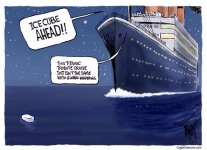- Reaction score
- 0
- Points
- 210
A fire in the sinking was argued many moons ago…aliens…wasn’t christened…the moon…all certainly questionable or a combination of factors sunk the Titanic.
AS FJAG posted on the Inquiry, fallow link:
Page 243 - British Inquiry into Loss of RMS Titanic Day 1 – 5:
5238. Did you help to get the coal out? - Yes. 5239. Did you hear when the fire commenced? - Yes, I heard it commenced at Belfast.
5240. When did you start getting the coal out? - The first watch we did from Southampton we started to get it out.
5241. How many days would that be after you left Belfast? - I do not know when she left Belfast to the day.
5242. It would be two or three days, I suppose? - I should say so.
5243. Did it take much time to get the fire down? - It took us right up to the Saturday to get it out.
http://www.titanicandco.com/inquiry/Days1-5/files/basic-html/page243.html
N Y Times: In Weak Rivets, a Possible Key to Titanic’s Doom By WILLIAM J. BROAD APRIL 15, 2008
Researchers have discovered that the builder of the Titanic struggled for years to obtain enough good rivets and riveters and ultimately settled on faulty materials that doomed the ship, which sank 96 years ago Tuesday.
The builder’s own archives, two scientists say, harbor evidence of a deadly mix of low quality rivets and lofty ambition as the builder labored to construct the three biggest ships in the world at once — the Titanic and two sisters, the Olympic and the Britannic.
For a decade, the scientists have argued that the storied liner went down fast after hitting an iceberg because the ship’s builder used substandard rivets that popped their heads and let tons of icy seawater rush in. More than 1,500 people died.
When the safety of the rivets was first questioned 10 years ago, the builder ignored the accusation and said it did not have an archivist who could address the issue.
http://www.nytimes.com/2008/04/15/science/15titanic.html
dailymail.co.uk: Did poor workmanship sink the Titanic? Physicist claims missing rivets were crucial to 'cascade' of events that sank liner
• Three million rivets held ship together
• Poor-quality rivets meant part of hull that hit iceberg was weaker than rest of vessel
• Vessel had been rushed out for maiden voyage
• Weak rivets meant air compartments ruptured
By Rob Waugh Published: 16:24 GMT, 2 April 2012 | Updated: 17:56 GMT, 2 April 2012
Poor engineering was the fatal factor that sent the Titanic on its journey two and a half miles to the bottom of the Atlantic 100 years ago.
The steel and wrought iron fasteners used to hold the metal plates together had been inserted unevenly, and some were low-quality - due to the vessel being rushed out for its maiden voyage.
The weak rivets meant that sealed compartments meant to keep the vessel afloat burst open - condemning the passengers to an icy death.
http://www.dailymail.co.uk/sciencetech/article-2124038/Did-poor-workmanship-sink-Titanic-Physicist-claims-missing-rivets-crucial-cascade-events-sank-liner.html
C.U.
AS FJAG posted on the Inquiry, fallow link:
Page 243 - British Inquiry into Loss of RMS Titanic Day 1 – 5:
5238. Did you help to get the coal out? - Yes. 5239. Did you hear when the fire commenced? - Yes, I heard it commenced at Belfast.
5240. When did you start getting the coal out? - The first watch we did from Southampton we started to get it out.
5241. How many days would that be after you left Belfast? - I do not know when she left Belfast to the day.
5242. It would be two or three days, I suppose? - I should say so.
5243. Did it take much time to get the fire down? - It took us right up to the Saturday to get it out.
http://www.titanicandco.com/inquiry/Days1-5/files/basic-html/page243.html
N Y Times: In Weak Rivets, a Possible Key to Titanic’s Doom By WILLIAM J. BROAD APRIL 15, 2008
Researchers have discovered that the builder of the Titanic struggled for years to obtain enough good rivets and riveters and ultimately settled on faulty materials that doomed the ship, which sank 96 years ago Tuesday.
The builder’s own archives, two scientists say, harbor evidence of a deadly mix of low quality rivets and lofty ambition as the builder labored to construct the three biggest ships in the world at once — the Titanic and two sisters, the Olympic and the Britannic.
For a decade, the scientists have argued that the storied liner went down fast after hitting an iceberg because the ship’s builder used substandard rivets that popped their heads and let tons of icy seawater rush in. More than 1,500 people died.
When the safety of the rivets was first questioned 10 years ago, the builder ignored the accusation and said it did not have an archivist who could address the issue.
http://www.nytimes.com/2008/04/15/science/15titanic.html
dailymail.co.uk: Did poor workmanship sink the Titanic? Physicist claims missing rivets were crucial to 'cascade' of events that sank liner
• Three million rivets held ship together
• Poor-quality rivets meant part of hull that hit iceberg was weaker than rest of vessel
• Vessel had been rushed out for maiden voyage
• Weak rivets meant air compartments ruptured
By Rob Waugh Published: 16:24 GMT, 2 April 2012 | Updated: 17:56 GMT, 2 April 2012
Poor engineering was the fatal factor that sent the Titanic on its journey two and a half miles to the bottom of the Atlantic 100 years ago.
The steel and wrought iron fasteners used to hold the metal plates together had been inserted unevenly, and some were low-quality - due to the vessel being rushed out for its maiden voyage.
The weak rivets meant that sealed compartments meant to keep the vessel afloat burst open - condemning the passengers to an icy death.
http://www.dailymail.co.uk/sciencetech/article-2124038/Did-poor-workmanship-sink-Titanic-Physicist-claims-missing-rivets-crucial-cascade-events-sank-liner.html
C.U.



